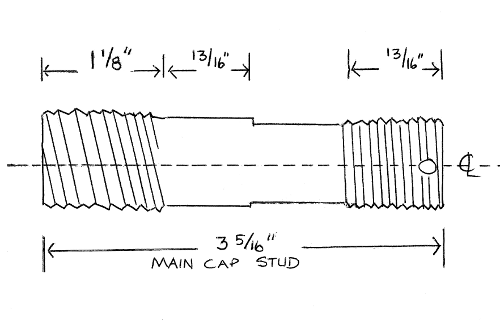Our flathead Fords have many special fasteners -- studs, nuts, bolts and washers. Some of the questions that come to mind are: Why did Ford have these made instead of using “off the shelf” hardware? What should we be using if we want the very best? And, are there any areas where we can improve on what Ford used around 70 years ago?
Let’s look at main bearing cap studs and bolts. (Illustration 1 – main stud expanded)


For retaining 1932–1948 Ford V8 main bearing caps, studs and nuts were used. The nuts are not too special – they are a castellated nut, also called a castle nut or slotted nut, which is a nut with notches cut into one end. The nut is to be used with a cotter pin through the hole provided in the stud; sometimes they were safety wired.
The studs are much more special. They have coarse threads on the block end and fine threads on the nut end. They also have two different diameters in between. The larger diameter is .498” and when installed, about one half of its length is in the block in a counter bore below the coarse threaded area. The lower half is indexed in the cap – it is like a locating dowel that works with the semicircular tongue on the cap and the groove in the block to precisely and securely locate the caps to the block.
The 1949–1953 engine uses bolts, two different lengths. In addition, the two for the front cap are self locking and do not use lock washers. The center and rear cap bolts are a little longer and do use lock washers. I believe this was done so that Ford could “form” the pan to be slimmer in the front area to provide better clearance to the frame cross member(s), steering, and other parts.
If you substitute bolts for the studs in the 1932–1948 engines, you are losing a little of the benefit of the Ford design. Also, in general, nuts on studs are a better fastening system than bolts, especially when the bolt is going into a casting. It is much easier to replace a stud due to damaged threads than to repair damaged threads in a casting from a bolt removal.
There are other special fasteners in our flatheads. Some are: cam gear bolts, pressure plate bolts, flywheel bolts and the center timing cover bolt on earlier engines. If you replace shouldered bolts with fully threaded bolts you will probably lose some of the benefit of the shoulder as it also functions as a dowel.
Another problem area when changing bolts is getting proper length. I have seen replacement bolts used that were too long to hold the flywheel to the crankshaft; this resulted in damage to the rear seal retainer as well as, I suppose, funny noises when the engine ran. I have taken engines apart that had bolts too long from the cam gear into the camshaft, and the extra length had damaged the thrust surface on the front of the block enough to require repair. Bolts have been installed that were too long to hold the distributor to the timing cover, contacting the machined grooves in the flutes of the timing gear. That probably made strange noises also. And what about the aluminum chips that went into the oil pan?
Even if the hole is blind a bolt that is too long can be trouble. If it bottoms out before tightening on to the part it is intended to hold the result can be a leak due to no binding force. That is in addition to the possibly damaged threads on the bolt and in the hole.
If bolts that are too long cause problems, then what about bolts that are too short? A rule of thumb is that for the threads to be as strong as the fastener, there must be 1 ½ times the diameter of thread engagement. A steel fastener threaded into a brass or aluminum part should have 2 times the diameter of thread engagement. If the casting is soft, like aluminum, a stud into the aluminum with a nut to hold the part is a much better plan.
Beware of using Teflon tape to seal pipe fittings, especially in fuel systems. Shreds of the tape can get into the carburetor and cause flooding or fuel starvation. If you must use Teflon tape, leave the inner two threads bare to guard against pieces being shed into the passage.
Finally, on the question of fasteners than could be improved from original, in my opinion there isn’t much room for improvement. ARP brand head studs are much stronger than OE Ford and the threads are more concentric with the stud center line than stock. They are much better quality than some of the other aftermarket head studs. One downside is that you cannot compensate by bending the stud to make them align with the hole in the head if you have any head stud threads in the block that are not at 90 degrees to the surface. I think you could break the block trying. The ARP nuts are very good as are their flat washers; thsoe washers work well when using aluminum cylinder heads.
Clutch pressure plate bolts are very good stock, there are some aftermarket that may be slightly better. ARP and Pioneer come to mind, but the stock pressure plate bolts are completely adequate.
If anyone has more to share on fasteners, please let me know.
Red Hamilton
This email address is being protected from spambots. You need JavaScript enabled to view it.
